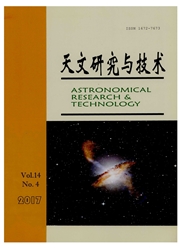

 中文摘要:
中文摘要:
1 m太阳望远镜多通道高分辨成像系统是望远镜的重要终端设备之一,目前由Hα通道(线心656.283 nm)和Ti O通道(705.8 nm)构成。主要介绍了多通道高分辨观测系统软件的设计。观测系统在功能上主要实现了Hα通道多波长点扫描观测模式,Ti O通道多时间分辨率观测模式,以及为满足多通道发展的需求,如常规观测通道的增加以及探测器的更换等,在系统架构上采用了松耦合的分布式分层结构。
 英文摘要:
英文摘要:
The New Vacuum Solar Telescope is an 1-meter, ground-based telescope which offers the unparalleled performance to solar observations. One of the important instruments in the NVST is the multi- channel high-resolution imaging system, and in the system five main work wave length ranges, including Hot, TiO-band, G-band, Ca II (854.2nm) and He I (1083.0nm) are covered. Up to now, Ha and TiO-band channels are being used. The Ha channel is an arrow-band imaging system, equipped with a tunable Lyot filter. The interpretation of the narrow-band filtergram is difficult due to the crosstalk between the brightness and the Dopplershift modulation, therefore the observational system is required to perform the multi-offband observation in Hot channel to obtain a scanned profile in order to get meaningful physical information. The TiO- band is abroad-band imaging system and uses a high-cadence CMOS. To achieve much higher cadence for some specific observations, it should support to decrease the FOV to increase the acquisition speed of the camera. However, the software provided by the camera manufacturedis failed to meet the observation need so that a new observational software system is constructed to satisfy the different observational needs in two channels. Taking the factors into account that another three channel will soon be added and high-cadence cameras will come into uses, the software architecture designed for NVST acquisition system should provide the scalability and the flexibility to adapt to changes in technologies throughout the lifetime of NVST. To achieve this goal, the distributed multi-terminal deployment and a loosely coupled system is adopted. The system is based on a tiered software architecture implemented as three primary systems that are the Observation Control System (OCS), the Instrument Control System (ICS) and the Data Handling System (DHS). The OCS interacts with our staff and coordinates the overall observational operations. The ICS manages the instruments and the DHS manages th
 同期刊论文项目
同期刊论文项目
 同项目期刊论文
同项目期刊论文
 期刊信息
期刊信息
